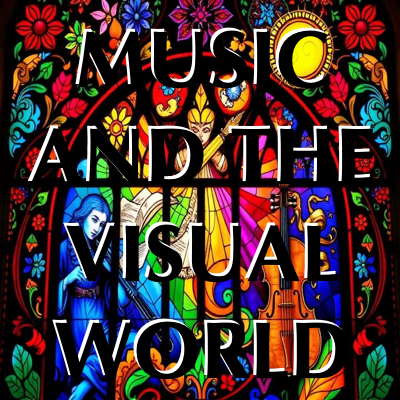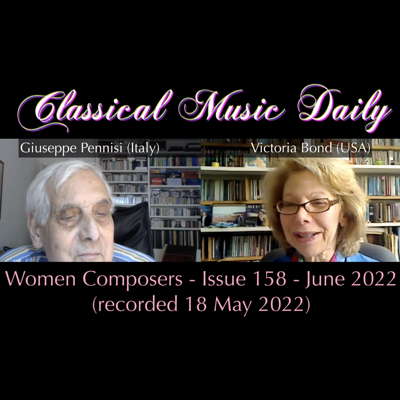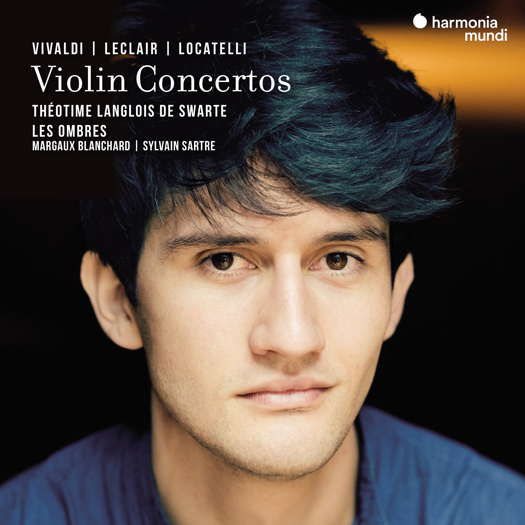- Ruth-Margret Pütz
- Martin Roscoe
- Sony BMG
- Avie
- Weinberger
- Woltera Gerharda Wansink
- Pirkanmaa
- Marsoulas
 DISCUSSION: John Dante Prevedini leads a discussion about Music and the Visual World, including contributions from Celia Craig, Halida Dinova and Yekaterina Lebedeva.
DISCUSSION: John Dante Prevedini leads a discussion about Music and the Visual World, including contributions from Celia Craig, Halida Dinova and Yekaterina Lebedeva.
 VIDEO PODCAST: Women Composers - Our special hour-long illustrated feature on women composers includes contributions from Diana Ambache, Gail Wein, Hilary Tann, Natalie Artemas-Polak and Victoria Bond.
VIDEO PODCAST: Women Composers - Our special hour-long illustrated feature on women composers includes contributions from Diana Ambache, Gail Wein, Hilary Tann, Natalie Artemas-Polak and Victoria Bond.

Much to Enjoy
Violin concertos by Vivaldi, Locatelli and Leclair senior delight GERALD FENECH
'Théotime Langlois de Swarte despatches these pieces with glorious dexterity, and the freshness of his playing is so engaging that you never tire of listening.'
This delightful issue teams together three important Baroque composers, who were not only contemporaries, two of them almost exact, but who were pioneers in the art of violin playing: Antonio Vivaldi (1678-1741), Pietro Locatelli (1695-1764) and Jean-Marie Leclair the Elder (1697-1764).
Antonio Vivaldi was born on 4 March 1678 in Venice, which is where he spent most of his life. His father taught him to play the violin and the two would often perform together. Antonio continued to study and practice the violin, even after he became a priest against his own will. He was called the 'Red Priest' because of his flaming red hair. However, after a while, his bad asthma prevented him from saying Mass. After that, Antonio spent all of his time composing and teaching. He taught at an orphanage for girls to play. People came from miles around to hear Vivaldi's talented students perform the beautiful music he had written.
Listen — Vivaldi: Allegro I (Violin concerto in B minor, RV 384)
(HMM 902649 track 5, 0:00-0:53) ℗ 2022 harmonia mundi musique sas :
Many people regarded Vivaldi as the best Italian composer of his time. He wrote concertos, operas, church music and a host of other pieces. In all, Vivaldi is said to have composed some five hundred concertos for various instruments, the majority of which are for the violin. His most famous pieces for the fiddle are the violin sonatas of 1709, L'estro armonico, which is a collection of twelve concerti for violin and strings of 1711, and between 1712 and 1717, four other opuses were composed comprising sets of concerti and sonatas. His ultimate masterpiece, The Four Seasons of 1721, was published in Amsterdam in 1725 and it remains his most performed piece to this day. He died, poor and abandoned, in Vienna on 28 July 1741, but he left a mark on music that still rings across the centuries.
Pietro Locatelli was born in Bergamo on 3 September 1695. He was still a young boy when his astonishing talent for playing the violin revealed itself. In 1711 he went to Rome to continue his studies; indeed, at that time it was the place to be as Arcangelo Corelli lived there. Locatelli did not actually study with Corelli, but he certainly absorbed a good deal of his influence. After 1723, Locatelli spent a lot of time travelling outside Italy, giving concerts all over Europe, particularly in Germany.
Unable to settle anywhere, he moved to Amsterdam in 1729 where he could publish his music and also work as a free musician and compose what he wanted. He lived and worked in the Dutch capital until his death in 1764. He had no pupils and never played in public, and being a master of the violin, Locatelli preferred not to have any professional musicians attend his private concerts for fear of them imitating him. His L'Arte del Violino, Op 3, shows the composer way ahead of his contemporaries, so this fear is rather perplexing. Printed in Amsterdam in 1733, this was one of the most influential publications in the early eighteenth century. It is a collection of twelve concertos for solo violin, strings and basso continuo with a 'capriccio' for unaccompanied violin inserted into the first and last movements of each concerto as a sort of 'cadenza'. Today they are usually extracted and played in isolation from the concertos.
Listen — Locatelli: Capriccio II (Violin concerto in E minor, Op 3 No 8)
(HMM 902649 track 10, 3:55-4:47) ℗ 2022 harmonia mundi musique sas :
His many early works show the influence of Corelli, while later pieces are closer to Vivaldi in style. Locatelli died in Amsterdam on 30 March 1764, leaving behind an unblemished reputation of exceptional violin playing that, even today, is still a cause of admiration and wonder.
Jean-Marie Leclair was born on 10 May 1697 in Paris. He was the son of a haberdasher and an amateur musician and, during his early years, he performed both as a dancer and violinist at the Lyon Opera. After a season with the Turin Opera in 1722, the composer came to Paris and published his first set of violin sonatas. By 1728, Leclair became part of the 'Concert Spirituel', one of the first public concert series, and after the death of his first wife, he married Louise Roussel.
His four-year appointment at the court of Louis XV was overshadowed by intense jealousy and numerous intrigues involving his fellow composer Jean-Pierre Guignon, which eventually forced Leclair to take an appointment with the Princess of Orange in Holland. In Amsterdam he took lessons with Locatelli and dedicated a number of works to the Princess. He returned to Paris in 1743, but quickly travelled to the court of the Infante Don Felipe at Chambery in Spain. Although Leclair returned to Paris in 1745 and there presented his only opera, Scylla et Glaucus, his future was undoubtedly bound to his skills as a violin virtuoso. By 1748 he was engaged as the principal violinist and director of his private orchestra by the Duc de Gramont.
After the breakup of his marriage, Leclair found himself in precarious circumstances on the outskirts of Paris. On the night of 23 October 1764, Leclair was found lying dead in the vestibule of his house in a pool of blood from three vicious stab wounds to the neck. No-one knows exactly who committed the murder, but the two main suspects were his wife Louise and his sister's son Guillaume-Francois Vial. The former was in dire financial straits and wanted to auction the house and all his belongings. The latter detested his uncle and might have wanted to take revenge for not having been given the help he expected to further his career. The mystery persists to this day.
Leclair's legacy primarily rests with an attractive number of compositions for the violin. At his best, his works embody simplicity most often combined with an earnest reflective spirit.
This is what the French poet Serré de Rieux had to say: 'Leclair is the first composer who, imitating nothing, has created something fine and new, something that is distinctively his own.'
Listen — Leclair: Largo - Adagio (Violin concerto in A minor, Op 7 No 5)
(HMM 902649 track 3, 0:45-1:41) ℗ 2022 harmonia mundi musique sas :
This superb CD can be said to be a family affair. Its three composers lived very different lives and their deaths were so contrasting, but, on the other side of the coin, their artistic careers were so deeply entwined. Indeed, their aim was to raise the bar where violin playing was concerned, and they totally succeeded. These concerts are prime examples of the development that was taking place during the first half of the eighteenth century in this genre of composition.
All the pieces are full of dazzling virtuosity, an intricately weaved melodic flow and, above all, a harmonic freedom that opened new horizons for future composers and interpreters.
Together, and with others of their ilk, they started a revolution that was to culminate a century later in the works of Paganini, Sarasate and Joachim, among others.
Théotime Langlois de Swarte despatches these pieces with glorious dexterity, and the freshness of his playing is so engaging that you never tire of listening. Also his sense of style and superlative technique are evident from start to finish.
Listen — Vivaldi: Allegro (Violin concerto in C, RV 179a, 'Per Anna Maria')
(HMM 902649 track 17, 4:18-4:54) ℗ 2022 harmonia mundi musique sas :
This is a must for all violin buffs, but for the less enthusiastic there is still much to enjoy.
Copyright © 10 March 2022
Gerald Fenech,
Gzira, Malta

CD INFORMATION: VIVALDI, LECLAIR, LOCATELLI VIOLIN CONCERTOS


